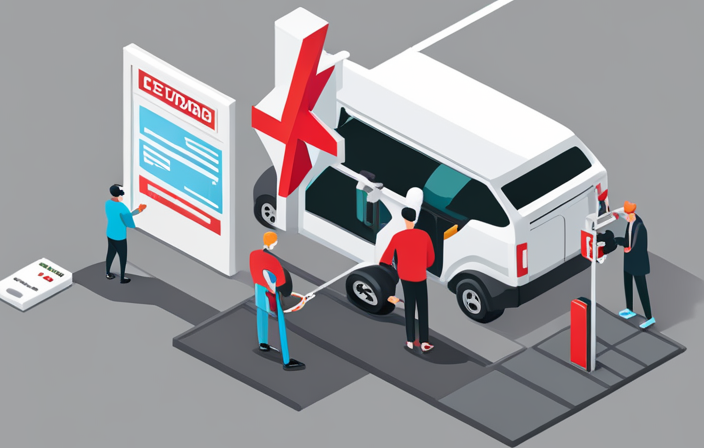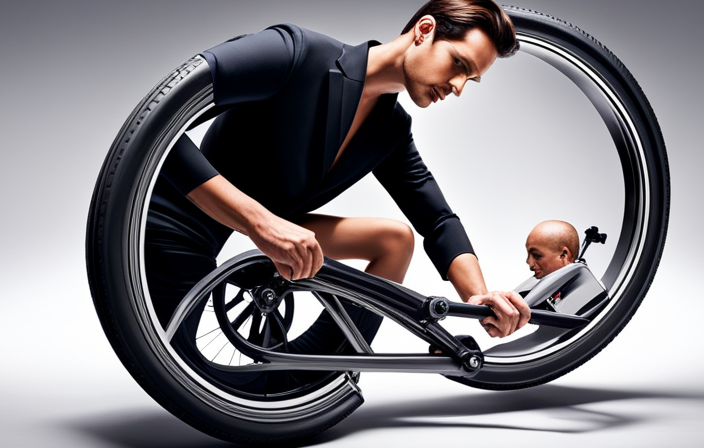As I sat quietly, observing my electric bike sitting idly in the corner with its battery drained and empty, I couldn’t help but ponder: why is my electric bike battery not charging?
With a sense of determination, I embarked on a journey of troubleshooting and investigation, delving into the intricacies of power connections, battery chargers, and wiring.
This article aims to unravel the mysteries behind this perplexing issue, offering technical insights and practical solutions to revive the lifeblood of our electric steeds.
Key Takeaways
- Troubleshooting charging issues by cleaning the battery terminals, checking for overheating issues, and looking for firmware or software updates.
- Considering environmental factors such as extreme temperatures and high humidity that can affect charging efficiency and battery damage.
- Consulting the electric bike manufacturer for specific recommendations and following their guidelines for charging.
- Seeking professional help for complex issues, access to specialized tools and equipment, and protecting the warranty.
Check the Power Connection
You should check if the power connection is secure and properly plugged in. To do this, inspect the power adapter and ensure that it is firmly connected to both the electric bike and the power outlet. Sometimes, the connection may appear secure but might not be fully plugged in, so be sure to double-check.
Additionally, check the battery capacity to ensure it is not depleted. If the battery is completely drained, it won’t charge until it reaches a minimum voltage level.
Once you have inspected the power connection and battery capacity, you can proceed to the next step, which is to inspect the battery charger. It is important to ensure all components are functioning properly to successfully charge your electric bike battery.
Inspect the Battery Charger
First, check if the charger is properly connected. Make sure the charging cable is securely plugged into both the battery and the power outlet. A loose connection can prevent the battery from charging.
To inspect the charging cable, look for any visible damage such as frayed wires or loose connectors. If you notice any issues, it may be necessary to replace the cable.
Next, troubleshoot the power outlet. Try plugging another device into the same outlet to ensure it is functioning properly. If the outlet is not working, you may need to find an alternative power source or have an electrician fix the outlet.
In conclusion, ensuring a proper connection between the charger and the battery is crucial for successful charging. After inspecting the charging cable and troubleshooting the power outlet, it’s time to move on to the next step: examining the battery connections.
Examine the Battery Connections
Next, take a look at the connections on your battery to ensure they are secure and free from any corrosion or debris. Inspecting the battery connections is crucial in troubleshooting why your electric bike battery won’t charge. Loose or poorly connected wires can prevent the proper flow of electricity, hindering the charging process. To assist you in visually understanding the importance of this step, refer to the table below:
| Connection | Description | Action Required |
|---|---|---|
| Positive (+) | Connects to the positive terminal | Check for tightness |
| Negative (-) | Connects to the negative terminal | Inspect for corrosion |
| Balance wires | Connects to the balancing circuit | Ensure no loose wires |
| Charging port | Connects to the charger | Verify no debris |
| Power switch | Connects to the bike’s power system | Look for any loose wires |
By thoroughly inspecting the battery connections and checking for loose wires, you can identify and resolve any potential issues. This will help you move on to the next step in troubleshooting: looking for faulty wiring.
Look for Faulty Wiring
To identify any potential issues, check for faulty wiring within your electric bike’s system.
Start by inspecting the battery casing and looking for any signs of frayed or damaged wires.
Check all the connections and ensure they are secure and properly attached.
If you notice any loose or broken wires, you may need to replace them or have a professional repair them.
It’s also important to test the battery capacity to determine if it is functioning properly.
Use a multimeter to check the voltage and ensure it matches the manufacturer’s specifications.
If the wiring appears to be in good condition and the battery capacity is within the correct range, you can move on to the next step of checking for a dead battery.
Check for a Dead Battery
If you’re experiencing issues with your electric bike, one thing you can do is check if the battery is dead.
Troubleshooting tips for a dead battery include examining the battery connections and ensuring they are securely attached to the bike. Additionally, inspect the battery for any physical damage, such as cracks or leaks, which could indicate a faulty battery.
It’s also important to check the battery voltage using a multimeter to ensure it is within the appropriate range. Common battery problems that can lead to a dead battery include overcharging, undercharging, or a faulty battery management system. If you suspect a dead battery, it may be necessary to replace it with a new one.
Moving on to the next step, let’s test the battery charger output to further diagnose the issue.
Test the Battery Charger Output
First, check the output of your battery charger to determine if it is functioning properly. Inspect the battery charger compatibility by ensuring that it is the correct charger for your electric bike’s battery model. Additionally, make sure that the charger’s voltage and current output match the requirements of your battery.
Troubleshoot the charging port by inspecting it for any physical damage or loose connections. Use a multimeter to test the charger’s output voltage and current. Compare these readings to the specifications provided by the manufacturer to ensure they are within the acceptable range. If the charger is not providing the correct output, it may need to be replaced.
In the next section, we will verify the battery management system to further diagnose the issue.
Verify the Battery Management System
Once you have confirmed the functionality of your battery charger, you can now proceed to verify the battery management system.
This step is crucial in troubleshooting any issues with your electric bike battery not charging.
The battery management system (BMS) is responsible for monitoring and controlling the battery’s performance and safety.
It ensures that the battery is charged and discharged correctly, protects against overcharging and overheating, and balances the individual cells within the battery pack.
Common battery management system issues that can prevent your battery from charging include faulty cell balancing, incorrect voltage readings, or a malfunctioning BMS circuit board.
To verify the BMS, you will need to inspect the battery voltage and assess its consistency and accuracy.
This will help identify any potential BMS-related problems that may be affecting the charging process.
Inspect the Battery Voltage
To inspect the battery voltage, I’ll need to check its consistency and accuracy. This involves inspecting the battery cells to ensure they are in good condition and functioning properly. I will examine each cell carefully, looking for any signs of damage or deterioration.
It’s also important to check the battery warranty to see if it is still valid, as this may affect the course of action. If the battery voltage is consistently low or if there are any irregularities, it could indicate a problem with the battery itself.
Once the battery voltage has been inspected and any issues addressed, the next step is to clean the battery terminals to ensure a proper connection.
Clean the Battery Terminals
After inspecting the battery voltage, the next step is to clean the battery terminals. This is an important process to ensure a proper power connection and maintain the efficiency of the electric bike battery. Here are some key steps to follow:
-
Inspect battery terminals: Carefully examine the terminals for any signs of corrosion, rust, or debris buildup.
-
Disconnect the battery: Before cleaning the terminals, it is crucial to disconnect the battery from the electric bike to avoid any electrical accidents.
-
Use a cleaning solution: Prepare a mixture of baking soda and water or a specialized terminal cleaner to remove any residue on the terminals.
-
Scrub the terminals: Gently scrub the terminals using a wire brush or a toothbrush to eliminate any stubborn buildup.
-
Test power connection: After cleaning, reconnect the battery and test the power connection to ensure it is secure and functioning properly.
Now, let’s move on to the next section and check for overheating issues.
Check for Overheating Issues
Now, let’s see if there are any overheating issues with the electric bike.
When it comes to charging problems, overheating can sometimes be a culprit. To inspect battery capacity, start by checking if the battery feels unusually hot to the touch during or after charging. Overheating can lead to reduced charging efficiency or even cause the battery to stop charging altogether.
Additionally, take a close look at the charging port. Ensure there are no signs of burn marks or damage that may indicate overheating. If you suspect overheating, troubleshoot by allowing the battery to cool down before attempting to charge it again.
Once you have ruled out overheating issues, we can move on to the next step and look for firmware or software updates.
Look for Firmware or Software Updates
Next, it’s important to check for any available firmware or software updates for your electric bike. Keeping your bike’s firmware up to date can provide several benefits.
Firmware updates often include improvements to battery charging algorithms, which can optimize the charging process and potentially resolve issues with charging. Additionally, firmware updates can address any software compatibility issues that may be hindering the charging process.
By ensuring that your electric bike is running the latest firmware and software, you can increase the chances of successfully charging your battery.
Once you have checked for updates, it’s time to consider environmental factors that may be affecting your battery’s charge.
Consider Environmental Factors
It’s important to take into account environmental factors that may impact the charging of your electric bike’s battery. These factors can have a significant effect on the performance and lifespan of the battery. Here are four key considerations:
-
Effects of Extreme Temperatures: Extreme heat or cold can negatively affect the battery’s ability to charge efficiently. High temperatures can cause the battery to overheat and degrade faster, while freezing temperatures can reduce its capacity.
-
Impact of Humidity on Battery Performance: High humidity levels can lead to condensation inside the battery, potentially causing damage to its components. This can result in decreased charging efficiency and overall battery performance.
-
Proper Ventilation: Ensure that your electric bike’s battery is in a well-ventilated area during charging. Good ventilation helps dissipate heat and prevents overheating, which can lead to decreased charging performance and battery life.
-
Storage Conditions: When not in use, store the battery in a cool and dry place to maintain its optimal performance. Avoid exposing it to extreme temperatures or high humidity levels.
Considering these environmental factors can help ensure the efficient charging and longevity of your electric bike’s battery. To learn more about specific recommendations for your electric bike model, consult the electric bike manufacturer.
[Transition sentence: Now let’s move on to the next step and consult the electric bike manufacturer.]Consult the Electric Bike Manufacturer
Make sure to reach out to the electric bike manufacturer for specific recommendations on how to contact customer support and consult them about your electric bike. They are the experts and can provide you with valuable information regarding your battery charging issue.
Start by researching common battery charging issues related to your electric bike model. Take note of any troubleshooting steps or solutions suggested by the manufacturer.
When reaching out to customer support, be prepared to provide them with specific details about your battery and the charging process you have been following. By doing so, they will be able to assist you more effectively.
It is important to consult the manufacturer to ensure that you are following the correct procedures and maximizing the lifespan of your battery. Understanding the specific guidelines from the manufacturer will help you resolve the charging issue efficiently without causing further damage.
Seeking professional help may be necessary if the manufacturer’s recommendations do not resolve the problem.
Seek Professional Help
If you’re still unable to resolve the issue, consider seeking professional help. Troubleshooting tips and common battery issues can be complex and require specialized knowledge.
Here are three reasons why seeking professional assistance is advisable:
-
Expertise: Professionals have the necessary skills and experience to diagnose and fix complex electrical issues that may be affecting your electric bike battery’s ability to charge.
-
Equipment: Professionals have access to specialized tools and equipment that may be required to accurately diagnose and repair battery-related problems. This ensures a more precise and efficient troubleshooting process.
-
Warranty: Seeking professional help can help protect your electric bike’s warranty. Attempting to fix the issue on your own may void the warranty, leaving you responsible for any repair costs.
If you’re still experiencing difficulties with your electric bike battery, it may be time to consider battery replacement options.
Consider Battery Replacement Options
After seeking professional help and determining that a battery replacement is necessary, it is important to consider the various battery replacement options available. Two factors to consider when choosing a replacement battery are the battery lifespan and battery maintenance.
To make an informed decision, it is helpful to create a comparison table that outlines the specifications of different battery options. This table can include information such as battery capacity, voltage, weight, and price. By comparing these factors, one can determine which replacement battery best suits their needs.
Battery lifespan is an important consideration as it determines how long the battery will last before needing to be replaced again. Additionally, battery maintenance is crucial for ensuring the longevity and optimal performance of the battery. Regular maintenance, such as proper charging and storage, can help extend the lifespan of the battery.
Considering these factors and consulting with professionals can help in making the best choice for a replacement battery that will efficiently charge your electric bike.
Frequently Asked Questions
How can I determine if my electric bike battery is dead?
To determine if my electric bike battery is dead, I can try troubleshooting charging issues first. If that doesn’t work, I may need a battery replacement. Analyzing the battery’s performance and considering its age can help in making this determination.
What should I do if my battery charger is not working?
If my battery charger is not working, I should first troubleshoot the battery charger by checking for any loose connections or damaged cables. Signs of a faulty battery connection may include intermittent charging or a complete lack of charging.
How often should I clean the battery terminals?
I clean the battery terminals of my electric bike every three months to prevent corrosion. Signs of corroded battery terminals include a white or greenish powdery substance on the terminals or difficulty starting the bike.
Can faulty wiring cause my electric bike battery to not charge?
Faulty wiring can indeed cause charging issues with an electric bike battery. It is crucial to regularly inspect and troubleshoot the wiring to ensure optimal performance and maximize the battery’s lifespan.
What are some common environmental factors that can affect the charging of my electric bike battery?
Common environmental factors that can affect battery charging include extreme temperatures, high humidity, and exposure to moisture. These issues can lead to corrosion, reduced battery capacity, and overall battery charging issues. Troubleshooting electric bike batteries is crucial in such cases.
Conclusion
In conclusion, troubleshooting an electric bike battery charging issue requires a systematic approach and attention to detail. Just like a detective solving a complex case, you must carefully examine the power connection, battery charger, battery connections, and wiring for any potential issues.
Environmental factors should also be taken into consideration. If all else fails, seeking help from the manufacturer or a professional is advised.
Ultimately, considering battery replacement options may be necessary to ensure a smooth and efficient ride.









